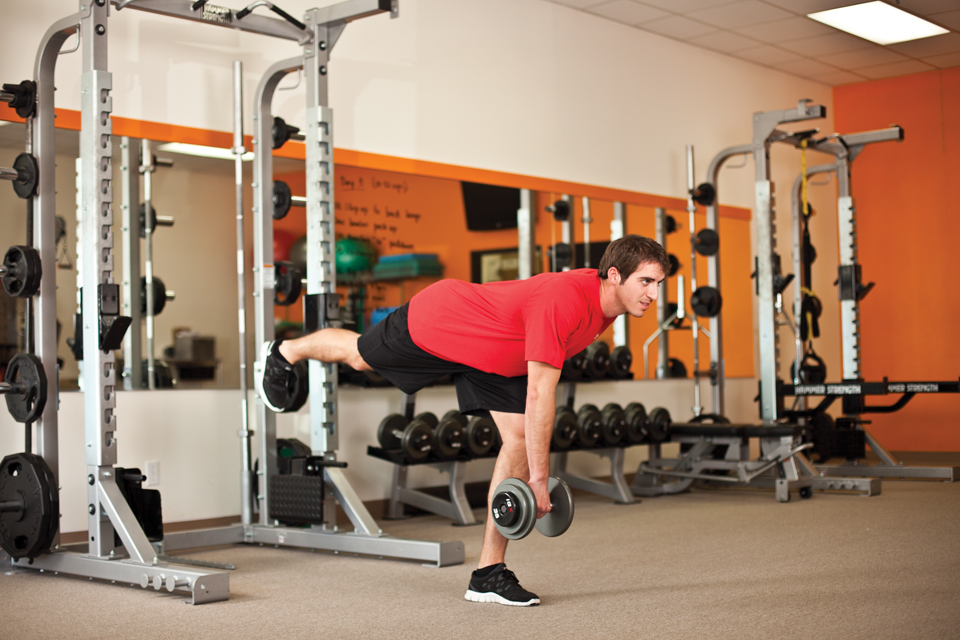Training Hip Drive for Your Best Scores

One of the most exciting new events for challenging the true heart of Austin athletes is the Austin Fittest coming up in June. Some of the tests in the challenge involve speed and acceleration to achieve your best times and scores as one of the challengers. One of the important steps to training for running efficiency and explosive quickness is hip drive, which allows for the most transfer of power from the lower body through the upper body.In order to train for hip drive or power, we can establish stronger hip extension, core strength, and single leg stability. By first establishing good loading patterns with full hip extension with a two-leg structured stance, we can really focus on strengthening the hip drive. Then, by moving to a single-leg stance exercise, we can focus on single hip control and stability, which is a key factor in transferring body weight efficiently through the running motion with each step. And this is especially true when trying to accelerate from a starting position to initiate a great takeoff in a sprint or agility run. Lastly, we have popular movements to train full body power that safely allow you to practice loading the body and get explosive extension of the ankle, knee, and hip, which is also referred to as triple extension in performance and strength training. A popular exercise to do this is the box jump, which when properly executed will allow triple extension and a safe, low impact landing on top of the box.
So let’s take a look at an example of these three key movements in order to train the hip drive:
Kettle Bell Swing
The purpose is to strengthen and master the movement of a hip hinge position to improve the hip extension strength for powerful lower body movements.
a. Start in a “hike” position with your feet shoulder-width apart, slight bend in the ankle and knee, and with hips flexed, creating a good hip hinge position.
b. Maintain neutral trunk position by pressing chest out and maintaining a flat back.
c. Initiate movement by focusing on the hip extension (hip drive) followed by full ankle and knee extension for a fully extended body, and use a two-handed grip on the kettle bell.
d. The arms act like ropes allowing the kettle bell to swing with the ball of the kettle bell out away from the body, and the movement should peak at eye-level.
e. Very important to fully extend hips at the top of swing and squeeze the extensor muscles of the hips.
f. Guide the kettle bell to back into downward swing as you re-hinge the hips and allow kettle bell to swing between legs. Forearms should brush the inside of the upper thigh.
Single Leg Dead Lift
Purpose is to improve strength and stability strength of the single leg hip extension movement that will improve running economy and initiate acceleration.
a. Start in an upright single-leg stance with a dumbbell in the opposite hand to your stance leg.
b. Lower your upper body and the single dumbbell by hinging at the hips and reaching back with the heel of the free leg until there is a straight line from the head to the heel close to parallel with the floor. Also use slight bend in the knee and ankle as you lower your body.
c. Keep both sides of hips parallel with ground and avoid side-to-side movement with the free leg.
d. Push through the heel of planted-foot; extending the hips, knee, and ankle until fully upright on the single leg and you have reached full hip extension to finish each repetition strong and with the most benefit.
Box Jump
The purpose is to train the explosive triple extension of the lower body with low impact or stress on joints. (For safety, always start with a low box and master the technique and height before advancing to a medium or high box jump)
a. Start in a standing position about 6-12 inches from the box
b. Begin loading the jump with a counter movement by flexing the ankles, knees, and hips with the most emphasis on hip flexion.
c. Do not pause, but immediately use the elastic quick loading to then quickly extend the lower body into triple extension through the jump.
d. Land softly and controlled on the box in an athletic stance with just slight hip, knee, and ankle flexion.
e. KEY is to gently step off the box to avoid dropping with impact and landing with impact on the floor. The point of the box jump is to train the jump with a low impact, safe landing on the box. It defeats this purpose if you dismount box with a jump to floor or dropping to the floor from the height of the box. And this also can add considerable stress to the joints.
Just remember that powerful speed and total-body acceleration depend on the power of the hips. So start preparing for your best sprint and agility scores for the Austin Fittest by practicing the actual tests and cross training with these movements to improve hip drive and power.
Diane Vives, MS, is an Advisory Member of the Under Armour Performance Training Council. An internationally recognized fitness expert, she has appeared in several publications such as Women’s Health, Shape, and Muscle & Fitness Hers.






